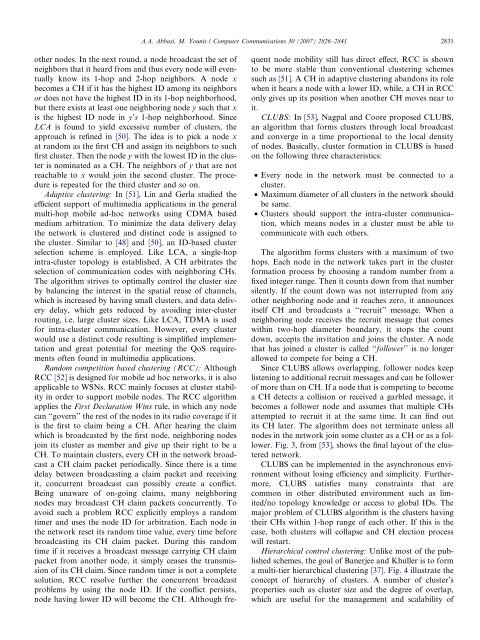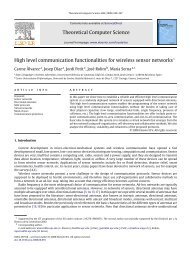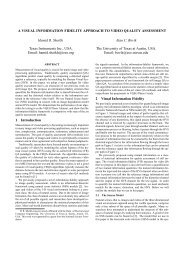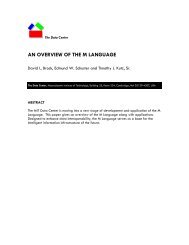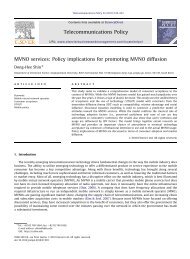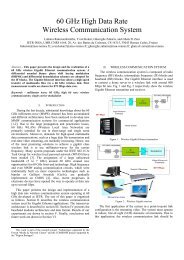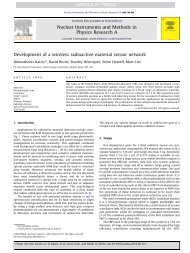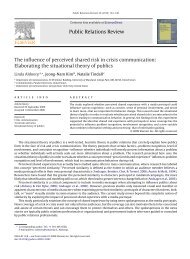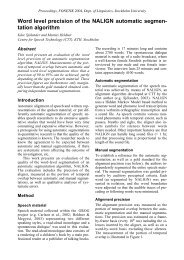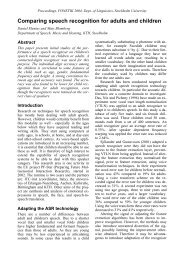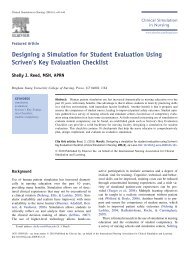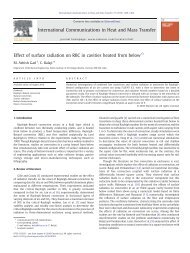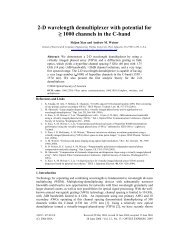A survey on clustering algorithms for wireless sensor networks
A survey on clustering algorithms for wireless sensor networks
A survey on clustering algorithms for wireless sensor networks
You also want an ePaper? Increase the reach of your titles
YUMPU automatically turns print PDFs into web optimized ePapers that Google loves.
other nodes. In the next round, a node broadcast the set of<br />
neighbors that it heard from and thus every node will eventually<br />
know its 1-hop and 2-hop neighbors. A node x<br />
becomes a CH if it has the highest ID am<strong>on</strong>g its neighbors<br />
or does not have the highest ID in its 1-hop neighborhood,<br />
but there exists at least <strong>on</strong>e neighboring node y such that x<br />
is the highest ID node in y’s 1-hop neighborhood. Since<br />
LCA is found to yield excessive number of clusters, the<br />
approach is refined in [50]. The idea is to pick a node x<br />
at random as the first CH and assign its neighbors to such<br />
first cluster. Then the node y with the lowest ID in the cluster<br />
is nominated as a CH. The neighbors of y that are not<br />
reachable to x would join the sec<strong>on</strong>d cluster. The procedure<br />
is repeated <strong>for</strong> the third cluster and so <strong>on</strong>.<br />
Adaptive <strong>clustering</strong>: In [51], Lin and Gerla studied the<br />
efficient support of multimedia applicati<strong>on</strong>s in the general<br />
multi-hop mobile ad-hoc <strong>networks</strong> using CDMA based<br />
medium arbitrati<strong>on</strong>. To minimize the data delivery delay<br />
the network is clustered and distinct code is assigned to<br />
the cluster. Similar to [48] and [50], an ID-based cluster<br />
selecti<strong>on</strong> scheme is employed. Like LCA, a single-hop<br />
intra-cluster topology is established. A CH arbitrates the<br />
selecti<strong>on</strong> of communicati<strong>on</strong> codes with neighboring CHs.<br />
The algorithm strives to optimally c<strong>on</strong>trol the cluster size<br />
by balancing the interest in the spatial reuse of channels,<br />
which is increased by having small clusters, and data delivery<br />
delay, which gets reduced by avoiding inter-cluster<br />
routing, i.e. large cluster sizes. Like LCA, TDMA is used<br />
<strong>for</strong> intra-cluster communicati<strong>on</strong>. However, every cluster<br />
would use a distinct code resulting is simplified implementati<strong>on</strong><br />
and great potential <strong>for</strong> meeting the QoS requirements<br />
often found in multimedia applicati<strong>on</strong>s.<br />
Random competiti<strong>on</strong> based <strong>clustering</strong> (RCC): Although<br />
RCC [52] is designed <strong>for</strong> mobile ad hoc <strong>networks</strong>, it is also<br />
applicable to WSNs. RCC mainly focuses at cluster stability<br />
in order to support mobile nodes. The RCC algorithm<br />
applies the First Declarati<strong>on</strong> Wins rule, in which any node<br />
can ‘‘govern’’ the rest of the nodes in its radio coverage if it<br />
is the first to claim being a CH. After hearing the claim<br />
which is broadcasted by the first node, neighboring nodes<br />
join its cluster as member and give up their right to be a<br />
CH. To maintain clusters, every CH in the network broadcast<br />
a CH claim packet periodically. Since there is a time<br />
delay between broadcasting a claim packet and receiving<br />
it, c<strong>on</strong>current broadcast can possibly create a c<strong>on</strong>flict.<br />
Being unaware of <strong>on</strong>-going claims, many neighboring<br />
nodes may broadcast CH claim packets c<strong>on</strong>currently. To<br />
avoid such a problem RCC explicitly employs a random<br />
timer and uses the node ID <strong>for</strong> arbitrati<strong>on</strong>. Each node in<br />
the network reset its random time value, every time be<strong>for</strong>e<br />
broadcasting its CH claim packet. During this random<br />
time if it receives a broadcast message carrying CH claim<br />
packet from another node, it simply ceases the transmissi<strong>on</strong><br />
of its CH claim. Since random timer is not a complete<br />
soluti<strong>on</strong>, RCC resolve further the c<strong>on</strong>current broadcast<br />
problems by using the node ID. If the c<strong>on</strong>flict persists,<br />
node having lower ID will become the CH. Although fre-<br />
A.A. Abbasi, M. Younis / Computer Communicati<strong>on</strong>s 30 (2007) 2826–2841 2831<br />
quent node mobility still has direct effect, RCC is shown<br />
to be more stable than c<strong>on</strong>venti<strong>on</strong>al <strong>clustering</strong> schemes<br />
such as [51]. A CH in adaptive <strong>clustering</strong> aband<strong>on</strong>s its role<br />
when it hears a node with a lower ID, while, a CH in RCC<br />
<strong>on</strong>ly gives up its positi<strong>on</strong> when another CH moves near to<br />
it.<br />
CLUBS: In [53], Nagpal and Coore proposed CLUBS,<br />
an algorithm that <strong>for</strong>ms clusters through local broadcast<br />
and c<strong>on</strong>verge in a time proporti<strong>on</strong>al to the local density<br />
of nodes. Basically, cluster <strong>for</strong>mati<strong>on</strong> in CLUBS is based<br />
<strong>on</strong> the following three characteristics:<br />
• Every node in the network must be c<strong>on</strong>nected to a<br />
cluster.<br />
• Maximum diameter of all clusters in the network should<br />
be same.<br />
• Clusters should support the intra-cluster communicati<strong>on</strong>,<br />
which means nodes in a cluster must be able to<br />
communicate with each others.<br />
The algorithm <strong>for</strong>ms clusters with a maximum of two<br />
hops. Each node in the network takes part in the cluster<br />
<strong>for</strong>mati<strong>on</strong> process by choosing a random number from a<br />
fixed integer range. Then it counts down from that number<br />
silently. If the count down was not interrupted from any<br />
other neighboring node and it reaches zero, it announces<br />
itself CH and broadcasts a ‘‘recruit’’ message. When a<br />
neighboring node receives the recruit message that comes<br />
within two-hop diameter boundary, it stops the count<br />
down, accepts the invitati<strong>on</strong> and joins the cluster. A node<br />
that has joined a cluster is called ‘‘follower’’ is no l<strong>on</strong>ger<br />
allowed to compete <strong>for</strong> being a CH.<br />
Since CLUBS allows overlapping, follower nodes keep<br />
listening to additi<strong>on</strong>al recruit messages and can be follower<br />
of more than <strong>on</strong> CH. If a node that is competing to become<br />
a CH detects a collisi<strong>on</strong> or received a garbled message, it<br />
becomes a follower node and assumes that multiple CHs<br />
attempted to recruit it at the same time. It can find out<br />
its CH later. The algorithm does not terminate unless all<br />
nodes in the network join some cluster as a CH or as a follower.<br />
Fig. 3, from [53], shows the final layout of the clustered<br />
network.<br />
CLUBS can be implemented in the asynchr<strong>on</strong>ous envir<strong>on</strong>ment<br />
without losing efficiency and simplicity. Furthermore,<br />
CLUBS satisfies many c<strong>on</strong>straints that are<br />
comm<strong>on</strong> in other distributed envir<strong>on</strong>ment such as limited/no<br />
topology knowledge or access to global IDs. The<br />
major problem of CLUBS algorithm is the clusters having<br />
their CHs within 1-hop range of each other. If this is the<br />
case, both clusters will collapse and CH electi<strong>on</strong> process<br />
will restart.<br />
Hierarchical c<strong>on</strong>trol <strong>clustering</strong>: Unlike most of the published<br />
schemes, the goal of Banerjee and Khuller is to <strong>for</strong>m<br />
a multi-tier hierarchical <strong>clustering</strong> [37]. Fig. 4 illustrate the<br />
c<strong>on</strong>cept of hierarchy of clusters. A number of cluster’s<br />
properties such as cluster size and the degree of overlap,<br />
which are useful <strong>for</strong> the management and scalability of


